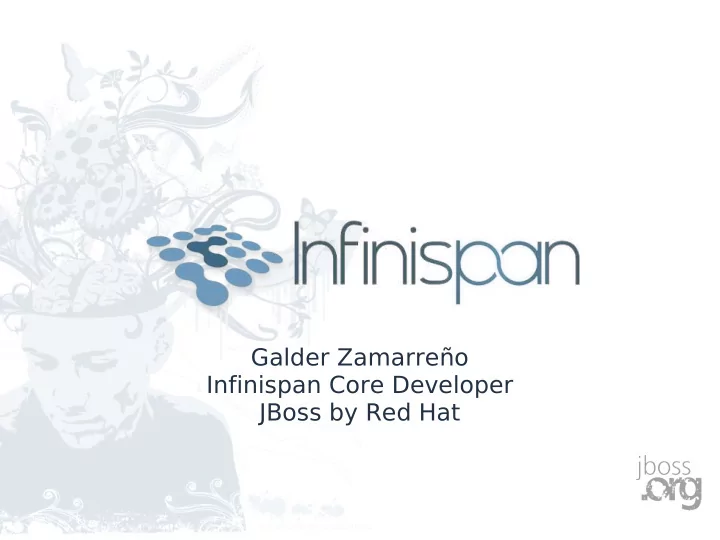

Galder Zamarreño Infinispan Core Developer JBoss by Red Hat
Who am I? ● Core developer for Infinispan and JBoss Cache ● Contributor and committer on JBoss AS, JGroups, Hibernate, JBoss Portal, etc.
Agenda ● What is Infinispan? ● Relationship with JBoss Cache ● New features ● Demo
What is Infinispan? ● Highly scalable data grid platform – 100% open source licensed (LGPL) – Based on some JBoss Cache code ● JBoss Cache = Tree structured cache – Replicated using JGroups – Supports JTA, evictions, cache stores, etc. ● New JSR-107(JCACHE) compatible API – Cache extends Map – Tree adapter API available for legacy apps
More scalable than JBoss Cache ● Internal structures more memory efficient – Tree --> Flat concurrent map – Eviction queue --> Ordered container ● Marshalling based on JBoss Marshalling – Smaller payloads + Poolable streams ● Early benchmarks – Significant performance improvements
Memory Consumption Comparison ● Test: Put 2 million serial objs into cache ● JBoss Cache 3.1: With 2gb, 1 million objs
Memory Consumption Comparison (2) ● Infinispan 4.0.0.Alpha4: With 700mb, 2 million objs
...borrowing best bits from JBoss Cache ● Multiversion Concurrency Control (MVCC) – New locking strategy in JBoss Cache 3.0 – Readers never locked! – Writers work on copy of cache entry ● Non-blocking state transfer – Senders generate state without stopping – Crucial when state is large
New features - distributed cache ● Consistent hash based distribution – Will allow us to scale to bigger clusters ● Lightweight, L1 cache for efficient reads – On writes, L1 invalidated ● Dynamic rebalancing ● Pluggable consistent hashing algorithms ● Already available in 4.0.0.Alpha5!
New features - asynchronous API ● putAsync(), putIfAbsentAsync() – Do not block, return a j.u.c.Future – Future.get() blocks till call completes ● Best of both sync and async worlds – Future.get() provides sync guarantees – Greater parallelism ● Already available in 4.0.0.Alpha5!
New features - Eager locking ● By default: locks acquired at commit time – Problematic if updating a shared counter ● New: Acquiring locks eagerly in cluster – Explicit: via API ● cache.lock(k) // acquire cluster wide lock on k – Implicit: via configuration ● Each modification implicitly acquires cluster wide lock if not already held. ● Already available in 4.0.0.Alpha5!
New features - client/server module ● Server module = cache wrapper over TCP ● Client module = cache proxy ● Highly pluggable! – Transport: XNIO, Netty, etc. – Protocols: memcached, custom, etc. ● Failover and load balancing ● Usable with current memcached clients ● Drop-in replacement memcached servers
New features - fine-grained model ● Successor to POJO Cache ● JPA-like interface: persist, find, remove... ● Will not rely on AOP, javassist...etc – More robust and easier to use/debug
New features - Others ● Query module – Execute Lucene queries against cache – Based on JBoss Cache - Searchable ● Distributed executors – Runnable/Callable executed on data set – Moves code, not data, around cluster
The End ● Demo ● Questions?
Recommend
More recommend